https://southasasif.wordpress.com/2019/07/25/the-many-faces-of-south-asasif/
The Many Faces of South Asasif
The South Asasif Conservation Project has developed numerous projects within the Project. Today you will hear from the leaders of two of these endeavors, Annie Haward, Franseca Jones and Taylor Bryanne Woodcock.
Part I: Reconstructing BD 17 in the tomb of Kharakhamun (TT 223)
Annie Haward and Francesca Jones
Annie Haward and Francesca Jones returned for another 4-week season at South Asasif on the 3rd of June. Their arrival coincided with the Eid Holiday, so the first few days were pleasantly spent settling into a shared flat with the team's Marion Brew, and going out for dinner with other colleagues while acclimatizing to the temperature change from the UK.
Then work started in earnest with a 3:45 am alarm call to be on site by 5:00 am for a seven hour working day. This early start was essential to cope with the summer temperatures, rising to 46° in the week prior to our arrival and due to rise to this again during our stay.
This was an exciting season for us, as work started with conservators Mohamed Shebib and Ahmed Hamdan to restore the south wall of the First Pillared Hall of Karakhamun, which had once held Chapter 17 of the Book of the Dead.
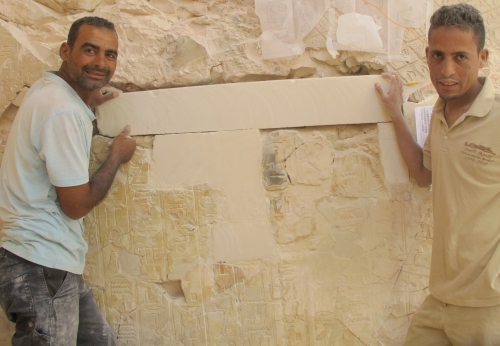
The work involved retrieving the fragments which had been boxed in column order the previous year, and checking them against our digital reconstruction typed in JSesh. Annie Photoshopped the photos of the original fragments into the suggested reconstruction. The preliminary reconstruction is based on the Lepsius version and other sources correlated with the remains of the text in situ. (see bibliography)
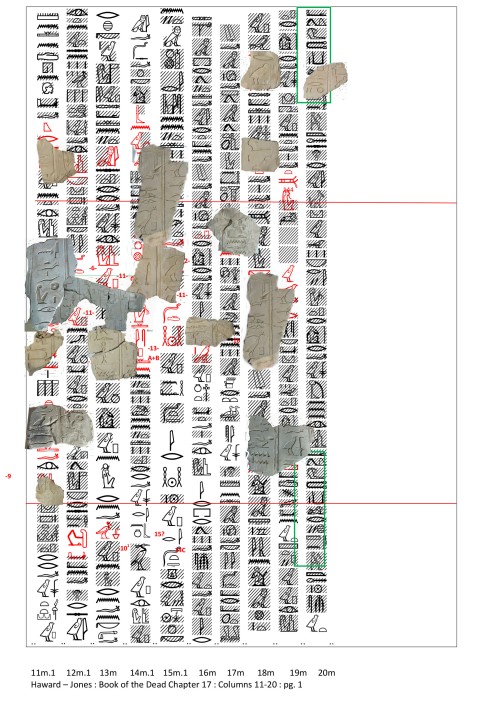
The main challenge was in taking detailed measurements of the hieroglyphs and spaces between them in each column to determine the exact placing of each fragment. This is essential work – largely carried out by Annie as fragments sometimes 'float' in a column with no adjacent wall text to assist with the exact location. It involved calculations down to the last half centimetre. The conservators were very careful that we all agreed with the positioning.
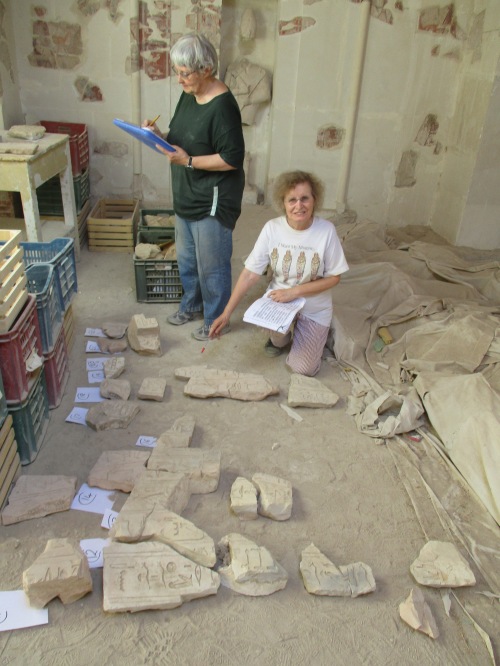
To fix one of the largest pieces (carved with hieroglyphs from columns 11-15) – which could then be used to place adjacent fragments – the conservators needed to consolidate the wall. The poor state of the limestone in this area explained why so much of the surface text had broken away from the wall in small pieces. In fact, the back of the limestone was so fragmented, Shebib and Ahmed had to put in long steel retaining bolts, epoxied into place, and then cover with a fresh face of new limestone. "Pockets" for the original fragments were carved into this casing stone, the fragments were inserted into the "pockets" and supported with lime plaster. All this took much longer than had been anticipated, but nevertheless progress was made in adding 6 fragments to the first 18 columns out of the total of 112.
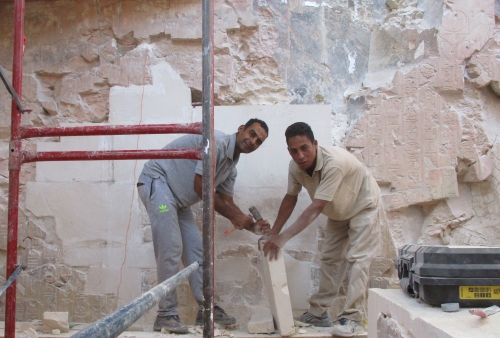
While this construction work was going on, Annie and Francesca retreated to the comparatively quiet tomb of Karabasken for a few days, where Ken Griffin had left boxes of fragments that could possibly be from Chapter 17. These were checked to ensure all columns of the text could be identified with certainty, then the piece was recorded, numbered, assigned to the correct columns, traced, photographed and boxed with its fellow column fragments. We were pleased to find at least three 'joins' with pieces we had already assigned, but in the time available could not deal with all the 'possibles' which were left for another year. A small fragment showing only a duck's neck caused us mystification, but Taylor managed to identify it for us using the hieroglyphs printed on her chilled water bottle container as a roast duck!
Approximately the first 20 columns of the wall have now been consolidated, and faced with beautiful white limestone slabs. Where the original text is missing, 6 of our fragments have been returned to their original positions on the wall. They were embedded by the conservators with such care and precision that one cannot tell that they had ever been lost. Our body of fragments to be replaced has been increased by 30 new pieces, giving a total identified of almost 200. In all a most successful 4 weeks work!
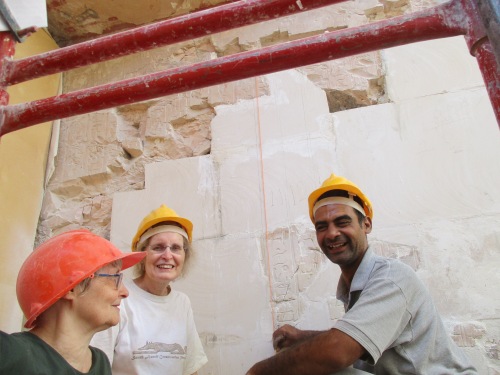
We would like to thank Ken Griffin for finding more pieces for us to work with and identifying parts of obscure hieroglyphs at a glance; and most of all our wonderful conservators, Mohamed Shebib and Ahmed Hamdan for all their hard work. We are looking forward greatly to 2020, when hopefully many of our remaining fragments of Spell 17 of the Book of the Dead will return to their rightful places on the South Wall of the First Pillared Hall of Karakhamun.
Chapter 17 Referenced Texts
UCL copy of Chapter 17 download (Transliteration and Translation)
(The version gives the Book of the Dead version as compiled from various sources by Naville in his standard edition of the New Kingdom and Third Intermediate Period papyri. The section numbering follows the edition by Allen 1974.)
https://www.ucl.ac.uk/museums-static/digitalegypt/literature/religious/bd17.html
Dr.K. Griffin
Unpublished MS copy of the Karakhamun wall text
Faulkner, R. O.; Editor Andrews, C. (1985) The Ancient Egyptian Book of the Dead (London : Guild Publishing)
Lepsius, R. (1842) Das Todtenbuch Der Ägypter Hieroglyphischen Papyrus in Turin Mit Einem Vorworte Sum Ersten Male Herausgegeben (Leipzig : Bei Georg Wigand)
O'Rouke, P. (2016) An Ancient Egyptian Book of the Dead; The Papyrus of Sobekmose. Translation, Introduction and Commentary (Brooklyn : Thames and Hudson / Brooklyn Museum)
Quirke, S. (2013) Going Out in Daylight: Prt M Hrw – the Ancient Egyptian Book of the Dead: Translations, Sources, Meanings (London : Golden House Publications)
Verhoeven, U. (1999) Das Totenbuch des Monthpriesters Nespasefy aus der Zeit Psammetichs I.
pKairo JE 95714 + pAlbany 1900.3.1, pKairo JE95649
(pMarseille 91/2/1 (ehem. Slg. Brunner) + pMarseille 291. Harrassowitz Verlag)
Part II: Karakhamun's Ceiling Project
Taylor Bryanne Woodcock
The South Asasif Conservation Project began clearing, restoring and reconstructing the tombs of Karabasken (TT 391), Karakhamun (TT 223) and Irtieru (TT 390) in 2006 – now the team is reaping the rewards of over a decade of hard work and tremendous skill, usually despite unbearable heat. It has been a huge honor for me to participate in several of the on-going projects at the SACP since I started in the summer of 2013.
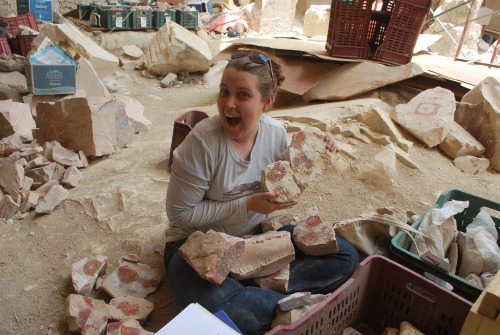
This season I became the new head of the Karakhamun Ceiling Project, which I had assisted Katherine Piper with briefly in 2015. The monumental tomb of Karakhamun (TT 223) contained the earliest painted ceiling from the Kushite-Saite period, borrowing from the corpus of brilliantly painted New Kingdom ceiling patterns in the Theban Necropolis but also contributing unique designs to the landscape.
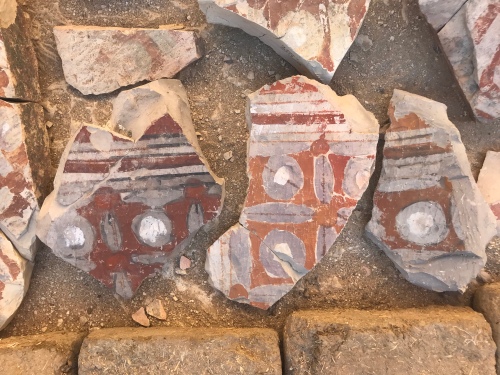
The decorative programme in the tomb of Karakhamun incorporated a vast painted ceiling in the First and Second Pillared Halls, decorated with patterns in red, blue, white, pink, orange, and yellow. When the tomb collapsed in the 1990s as the result of poor quality limestone, extensive quarrying, and heavy flooding, the decorated ceiling broke into thousands of painted limestone fragments which now give us a tantalizing glimpse of how the ceiling appeared over two thousand years ago. The ultimate goal of the Karakhamun Ceiling Project is a partial reconstruction of Karakhamun's beautiful patterns, but even in its fragmented state, his ceiling has much to tell us about tradition, innovation, and symbolism in Kushite-period tombs.
This year thousands of ceiling fragments were moved to the Open Court of Karabasken to allot them the space they needed for study and reconstruction. This season, the Ceiling Project team (myself, along with Scott Allan, Laura Chilvers, and Aimée Vickery) sorted and documented over seven thousand painted limestone fragments, which granted us a preliminary understanding of the patterns from Karakhamun's ceiling and of the possible surface areas that each pattern was allotted in the tomb based on the size and number of preserved fragments. We hope that similar find locations for fragments of the same pattern will help us to identify their original placement within the monumental pillared halls.
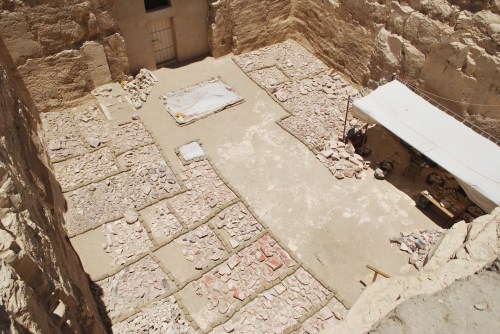
Ancient artists incorporated twenty painted patterns into the tomb's two pillared halls: eight bead-net patterns, four checkerboard patterns, three floral patterns, two rhombus patterns, and several others. The patterns vary greatly in degrees of detail and in pattern consistency – some were clearly designed to cover a large surface area with easily-defined shapes, while others featured smaller, more delicate designs.
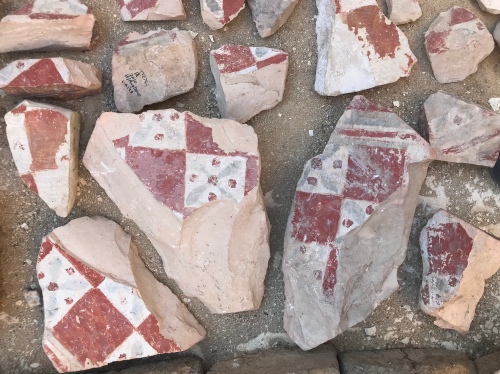
Next year, the reconstruction process of the Ceiling Project will begin in earnest and we hope to eventually display Karakhamun's vibrant ceiling patterns at the site so that visitors can appreciate their color and design for generations to come. In the meantime, there is much that Karakhamun's ceiling has to reveal about the origins and meanings of its patterns, and the behaviors of the individual artists who painted them.
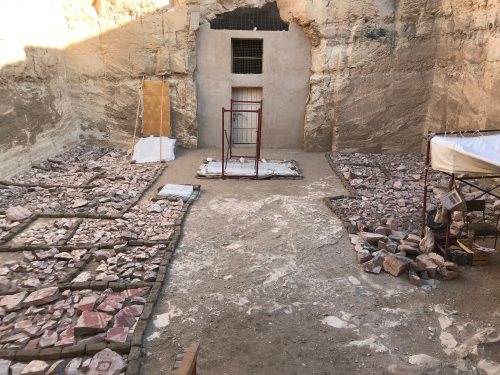
Even though the numerous ceiling patterns of the Theban Necropolis have impressed visitors for centuries, they remain largely unstudied and unpublished. The ceiling patterns in the North Asasif tombs, such as Pabasa, may be better known but Karakhamun's ceiling set the precedent for Kushite-Saite tomb ceiling decoration, acting as the bridge between New Kingdom and Late Period traditions. This new project at the South Asasif allows us the opportunity to study Kushite-Saite ceiling décor in the context of the Theban landscape through the need for careful preservation and reconstruction.
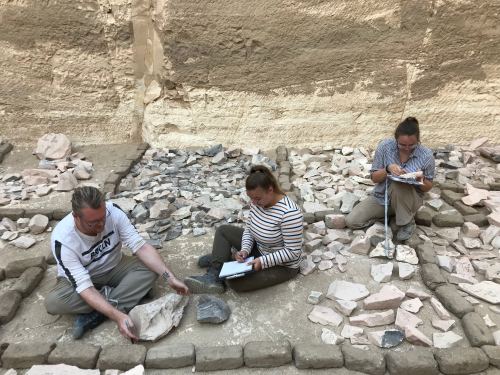
-- Sent from my Linux system.
No comments:
Post a Comment